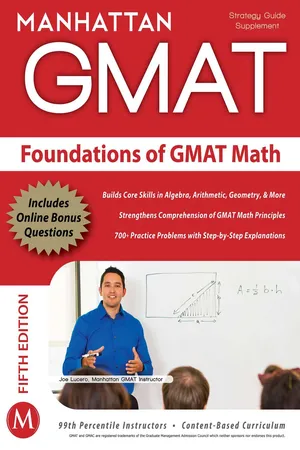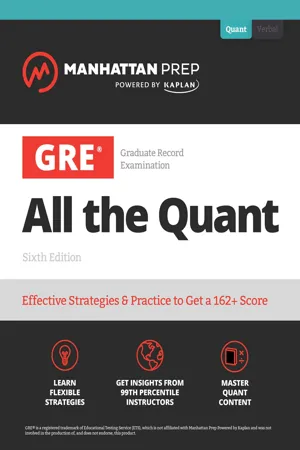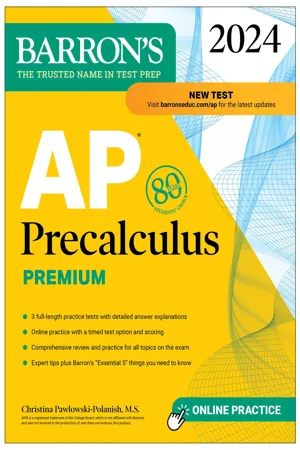Mathematics
Properties of Exponents
The properties of exponents are rules that govern the manipulation and simplification of expressions involving exponents. These properties include the product rule, quotient rule, power rule, zero exponent rule, and negative exponent rule. They are used to simplify and solve equations involving exponents, making calculations more efficient and manageable.
Written by Perlego with AI-assistance
Related key terms
Related key terms
1 of 4
Related key terms
1 of 3
7 Key excerpts on "Properties of Exponents"
- eBook - ePub
- Lisa Healey(Author)
- 2021(Publication Date)
- Chemeketa Press(Publisher)
. Perform the division by canceling common factors.Notice that the exponent of the quotient is the difference between the exponents of the divisor and dividend. So the shortcut would look like this:In other words, when dividing exponential expressions with the same base, we write the result with the common base and subtract the exponents. This is the quotient property of exponents, which can be stated in general terms asFor the time being, we must be aware of the condition m > n. Otherwise, the difference m − n could be zero or negative. We’ll explore those possibilities soon.There are three other basic Properties of Exponents. These rules can be demonstrated by expanding and simplifying each expression as we did with the product and quotient properties. The five basic Properties of Exponents are listed below.Five Properties of ExponentsFor any real numbers b and c and natural numbers m and n,Example 1Use the product and quotient properties to simplify the following expressions.1.b5 · b32.(−2)5 · (−2)3.x2 · x5 · x34.5.6.Solutions1.b5 · b3 = b3+5 = b8We can extend the product property of exponents to simplify a product of three factors having the same base. Simply add the exponents of all three factors:2.(−2)5 · (−2) = (−2)5 (−2)1 = (−2)6 = 643.x2 · x5 · x3 = x2+5+3 = x104.5.6.We can use all five Properties of Exponents in a variety of combinations to simplify more complex expressions. At first, it’s wise to proceed methodically using one property at a time. With practice, you may find that you’re able to combine some of the steps.Example 2Simplify the following expressions.1.(2 b3 c6 )42.(5b c5 )(9 b4 c7 )3.4.Solutions1.(2b3 c6 )42.(5bc5 )(9b4 c7 )3.4.Practice BSimplify the following expressions. Turn the page to check your work.1.t3 · t6 · t52.(6a6 b3 )(4a9 b2 )3.4.(4x2 y7 )55.C. Zero Exponents and Negative Exponents
- eBook - ePub
- Manhattan GMAT(Author)
- 2011(Publication Date)
- Manhattan Prep Publishing(Publisher)
Chapter 3: Exponents & RootsIn This Chapter:• Rules of exponents • Rules of roots Basics of ExponentsTo review, exponents represent repeated multiplication. The exponent, or power, tells you how many bases to multiply together.53 = 5 × 5 × 5 = 125 Five cubed equals three fives multiplied together, or five times five times five, which equals one hundred twenty-five. An exponential expression or term simply has an exponent in it. Exponential expressions can contain variables as well. The variable can be the base, the exponent, or even both.a4 = a × a × a × a a to thefourth equals four a's multipliedtogether, or a times atimes a times a.
Any base to the first power is just that base.3 x= 3 × 3 ×…× 3 Three to thexth power equals three times three timesdot dot dot times three.There are x three's in theproduct, whatever x is.
Memorize the following powers of positive integers.71 = 7 Seven to the first equals seven. Squares Cubes 12 = 122 = 432 = 942 = 1652 = 2562 = 3672 = 4982 = 6492 = 81102 = 100112 = 121122 = 144132 = 169142 = 196152 = 225202 = 400302 = 900 13 = 123 = 833 = 2743 = 6453 = 125103 = 1,000 Powers of 2 21 = 222 = 423 = 824 = 1625 = 3226 = 6427 = 12828 = 25629 = 512210 = 1,024 Powers of 3 31 = 332 = 933 = 2734 = 81 Powers of 4 41 = 442 = 1643 = 64
Remember PEMDAS? Exponents come before everything else, except Parentheses. That includes negative signs.Powers of 5 51 = 552 = 2553 = 125 Powers of 10 101 = 10102 = 100103 = 1,000 –32 = –(32 ) = –9 The negative of three squared equals the negative of the quantity three squared, which equals negative nine. To calculate –32 , square the 3 before you multiply by negative one (–1). If you want to square the negative sign, throw parentheses around –3.(–3)2 = 9 The square ofnegative three equals nine. In (–3)2 , the negative sign and the three are both inside the parentheses, so they both get squared. If you say “negative three squared,” you probably mean (–3)2 , but someone listening might write down –32 - eBook - ePub
GRE All the Quant
Effective Strategies & Practice from 99th Percentile Instructors
- (Author)
- 2023(Publication Date)
- Manhattan Prep(Publisher)
must equal 1.Exponent Rule 6:x0 = 1 Any base raised to the power of zero is equal to 1. A Negative Exponent
An exponent can be negative. While negative exponents have all the same properties as positive ones, they can be confusing to interpret. If you start from 22 and divide by the base, 2, you’ll move “down” one power from 22 to 21 .22 ÷ 2 = 22−1 = 21 = 2The below table illustrates what happens if you keep dividing by 2. The first column shows how to simplify an expression using plain math, while the second column shows how to simplify the exact same expression using exponent rules:Plain math: Exponent form: Therefore: 21 ÷ 2 = 2 ÷ 2 = 1 21 ÷ 2 = 21−1 = 20 20 = 1 20 ÷ 2 = 20−1 = 2−1 What happened there? When you drop below x0 to the negative exponent x–1 , the value doesn’t turn negative. Rather, the value turns into a fraction and the base ends up in the denominator of the fraction. This trend continues if you keep dividing by 2.When you see a negative exponent, first take the reciprocal of the base. In the above examples, the base is 2, so its reciprocal is .Next, put parentheses around the entire fraction and use the positive version of the exponent you started with. In the last example shown above, the starting exponent was −3, so the positive version is 3. As a result, .Here are three more examples of these rules:Exponent Rule 7:For any base raised to a negative power, take the reciprocal of the base and raise it to the positive power. For any base raised to the −1 power, take the reciprocal of the base and yo’re done. Check Your Skills
- If , what is y ?
- Simplify: (x−3 )(x−4 )
Answers can be found on page 143.Special Bases
The base of an exponent can be positive, negative, or zero. It could also be either an integer or a fraction. Chapter 2: Exponents introduced the basics of negative exponents. In this section, you’ll learn more about negative bases as well as other special bases. - No longer available |Learn more
- Christina Pawlowski-Polanish(Author)
- 2023(Publication Date)
- Barrons Educational Services(Publisher)
x).The power of a power law of exponents also leads to an interesting graphical transformation.Power Property and Change of BaseThe power property for exponents states that (bm)n= b(mn). Graphically, this property implies that every horizontal dilation of an exponential function, f(x) = b(cx), is equivalent to a change of the base of an exponential function, f(x) = (bc)x, where bcis a constant and c ≠ 0.ExampleGiven the exponential function g(x) = 81x, state the factor of the horizontal dilation of g(x) if its parent function is f(x) = 3x.SolutionSince 81 = 34 , then g(x) = 81x= (34 )x= 34x. Therefore, the graph of g(x) is a horizontal shrink by a factor of of the graph of f(x).ExampleShow that the graph of g(x) = is a reflection over the y-axis of the graph of f(x) = 4x.SolutionUsing the negative exponent law, g(x) = = 4−x= f(−x). From the transformations section in this book, f(−x) reflects the graph of the original function, f(x), over the y-axis.ExampleRewrite the function h(x) = in the form f(x) = abx.SolutionUsing the exponent laws, .5.3 Exponential Function Context and Data ModelingPrevious chapters discussed how to recognize if tables of data represented linear or quadratic functions. Exponential functions model growth patterns where successive output values over equal-length input value intervals are proportional. When the input values are whole numbers, exponential functions model situations of repeated multiplication of a constant to an initial value.ExampleDetermine whether the functions in the tables below are linear, exponential, or neither. For those that are linear, find a linear function that models the data. For those that are exponential, find an exponential function that models the data.1.Table 5.12.Table 5.23.Table 5.3SolutionFor each table, the input values are of equal length, so calculate the average rate of change. If the average rate of change is constant, the function is linear. Also compute the ratio of consecutive outputs. If the ratio is constant, the function is exponential. - eBook - ePub
The Parallel Curriculum in the Classroom, Book 2
Units for Application Across the Content Areas, K-12
- Carol Ann Tomlinson, Sandra N. Kaplan, Jeanne H. Purcell, Jann H. Leppien, Deborah E. Burns, Cindy A. Strickland(Authors)
- 2005(Publication Date)
- Corwin(Publisher)
6The Power of Exponents
A Middle or High School Math UnitIncorporating All Four Parallels Kristen Wogman BaronBACKGROUND FOR UNIT
The topic of exponents and exponential functions is an important part of any Algebra I course. Students need to be able to multiply and divide exponential expressions, use scientific notation, and solve and graph simple exponential functions. This unit puts these initial concepts into a context to which students can relate and for which they can see a purpose.Students act as mathematicians in this unit as they discover the rules of exponents and the common characteristics of exponential function graphs. They also learn to use graphing calculator technology as a tool to aid them in computations. They act as scientists as they explore scientific notation of large and small numbers in the context of astronomy and microbiology. They act as financial planners as they learn to invest money for maximum profit.There are several options for assessment at the end of the unit. These options relate to the different fields of study we cover in the unit. Students choose an assessment based on their interest in a field area. This allows them to work in areas of interest to share their knowledge of the subject. - eBook - ePub
- Toby Wagner(Author)
- 2021(Publication Date)
- Chemeketa Press(Publisher)
The last two expressions from the previous example illustrate the importance of parentheses when applying exponents. Based on the order of operations, an exponent must be applied before multiplication takes place — unless the multiplication is inside of parentheses. In other words, we should only apply an exponent to the thing that appears immediately to the left of it.You may recall seeing this in previous math classes with expressions involving negative numbers. Remember that a negative sign signifies that something is being multiplied by −1. In the absence of parentheses, we must apply an exponent before a negative sign. Let’s see how this looks with the number −3:Now, let’s look at a couple of expressions involving the quotient rule and the zero-exponent rule.Now we’re ready to tackle the problem from the beginning of this section. This problem requires us to use all of the rules of exponents we’ve learned so far.Example 8Simplify the following expressions.1.2.SolutionsIn this problem, we use the two-step process described before example 6.1.2.In this problem, we treat (x + 4) and (x – 1) as single entities and use the same approach we used in the first expression. We use the quotient rule to combine the (x + 4) and (x – 1) expressions.Example 9Simplify:SolutionWe will start by multiplying these fractions together. This will require us to use the product rule for exponents. After that, as we work through the rest of the problem, the quotient rule and the zero-exponent rule will be used as well.In the previous example, the numerical coefficients gave us the fraction when multiplied. This fraction then had to be simplified. However, when multiplying fractions, we can use cross-canceling to reduce the numerical coefficients before combining the fractions. In the previous example, that step would look like this:By cross-canceling, we immediately arrive at the simplified fraction - eBook - ePub
Differentiating Instruction in Algebra 1
Ready-to-Use Activities for All Students (Grades 7-10)
- Kelli Jurek(Author)
- 2021(Publication Date)
- Routledge(Publisher)
- 4. Use the multiplication Properties of Exponents to simplify the following expressions.
- 22 · 23 ────────
- 54 · 55 ────────
- a3 · a2 ────────
- (43 )2 ────────
- (d5 )3 ─────────── I'm sure ─── I'm not sure
- 5. Use the division Properties of Exponents to simplify the following expressions.
- m ─────────
- v ────────
- v ────────
- v ────────
- v ──────── ─── I'm sure ─── I'm not sure
- 6. Use the zero and negative Properties of Exponents to simplify the following expressions.
- 20 ────────
- a0 · 24 ────────
- 3-3 ────────
- (4-3 )2 ────────
- (2d)-5 ─────────── I'm sure ─── I'm not sure
- 7. For the equation y = 450 (1.08 )4 identify the starting value, the growth factor, the time period, and the final value.
- Starting value:─────
- Growth factor:─────
- Time period: ─────
- Final value: ─────
- ─── I'm sure ─── I'm not sure
- 8. Write an exponential function to model the following situation and then answer the question. Find the account balance after 3 years if you deposit $650 in an account that pays 4% annual interest compounded annually. ────────
Index pages curate the most relevant extracts from our library of academic textbooks. They’ve been created using an in-house natural language model (NLM), each adding context and meaning to key research topics.
Explore more topic indexes
Explore more topic indexes
1 of 6
Explore more topic indexes
1 of 4






